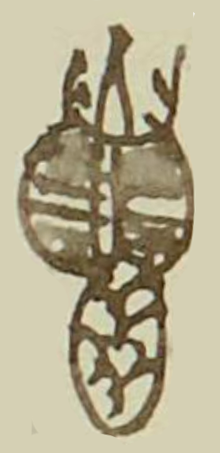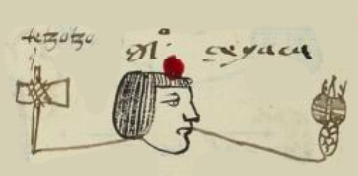Cenyacan (MH838v)
This black-line drawing of the compound glyph for the personal name Cenyacan (“Commander”) is attested here as a man’s name. The glyph shows a war shield, which usually stands for yaotl, in the sense here of “combatant.” Underneath the shield, and poking out slightly, is a turtle (ayotl), a near homophone, used as a phonetic complement for yaotl. Below that is a dried ear of maize (centli, also spelled cintli sometimes). The ear of corn is a phonetic indicator for the start of the name Cen-. The full name comes from the verb cenyacana, to command or govern, a compound of cen (entirely) and yacana (lead).
Stephanie Wood
The letter “n” has been dropped, apparently inadvertently, from both cen- and -yacan.
Stephanie Wood
dio çeyaca
Diego Cenyaca
Stephanie Wood
1560
Jeff Haskett-Wood
mandar, gobernar, liderar en la guerra, maíz, mazorcas, tortugas, chimalli, escudos, nombres de hombres

cenyacana, to lead, command, govern, https://nahuatl.wired-humanities.org/content/cenyacan
Comandante
Stephanie Wood
Matrícula de Huexotzinco, folio 838v, World Digital Library, https://www.loc.gov/resource/gdcwdl.wdl_15282/?sp=751&st=image.
This manuscript is hosted by the Library of Congress and the World Digital Library; used here with the Creative Commons, “Attribution-NonCommercial-ShareAlike 3.0 License” (CC-BY-NC-SAq 3.0).






